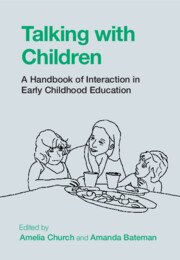Book contents
- Talking with Children
- Talking with Children
- Copyright page
- Dedication
- Contents
- Figures
- Tables
- Contributors
- Acknowledgements
- Notes on Transcription Conventions
- Introduction
- Part I Talk as Social Action
- Part II Pedagogy in Interaction
- 8 Literacy
- 9 Storytelling
- 10 Digital Technologies
- 11 Mathematics
- 12 Creativity
- 13 Multilingualism
- 14 Belonging
- Part III Interaction and Inclusion
- Index
- References
12 - Creativity
from Part II - Pedagogy in Interaction
Published online by Cambridge University Press: 16 June 2022
- Talking with Children
- Talking with Children
- Copyright page
- Dedication
- Contents
- Figures
- Tables
- Contributors
- Acknowledgements
- Notes on Transcription Conventions
- Introduction
- Part I Talk as Social Action
- Part II Pedagogy in Interaction
- 8 Literacy
- 9 Storytelling
- 10 Digital Technologies
- 11 Mathematics
- 12 Creativity
- 13 Multilingualism
- 14 Belonging
- Part III Interaction and Inclusion
- Index
- References
Summary
Child-focused conversation analysis research on children’s storytelling practices has drawn attention to family, pre- and early school storytelling practices in a variety of contexts and at different ages. The research has been conducted on storybook reading, and on storytelling during family mealtimes, in bilingual settings and during play. It has shed light on displays of children’s interaction skills, and has also shown how storytelling changes across time.
- Type
- Chapter
- Information
- Talking with ChildrenA Handbook of Interaction in Early Childhood Education, pp. 247 - 265Publisher: Cambridge University PressPrint publication year: 2022
References
- 2
- Cited by

